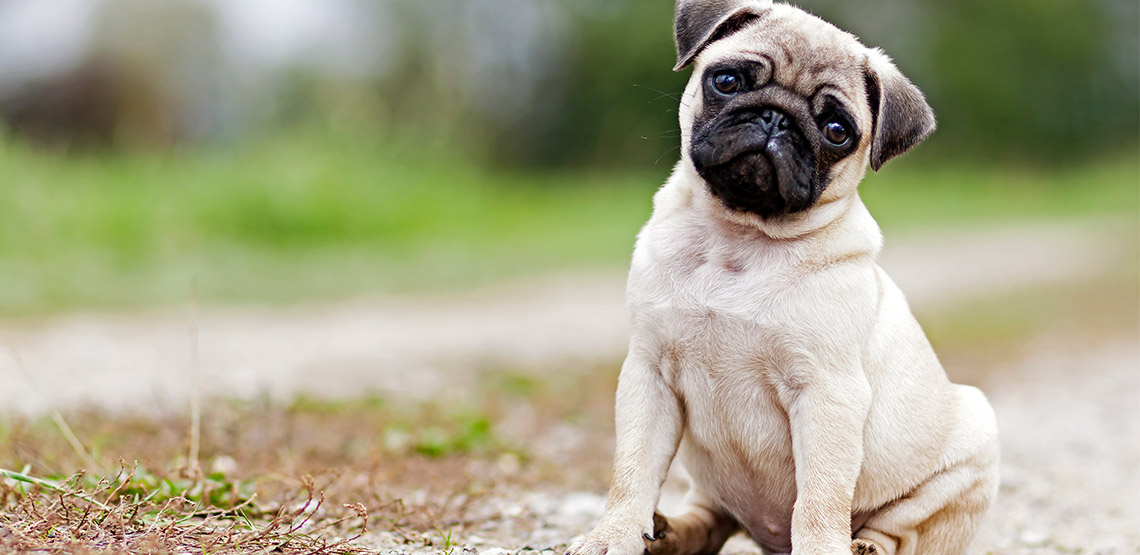A complete guide to pug dogs
Pugs are characterized by their instantly recognizable wrinkled, compact face. Tiny, playful and mischievous, pug puppies grow up to make outstanding family pets due to their patient and gentle disposition, love of play and attention, and high tolerance for young children.
Appearance
Height: Both male and female pug dogs average 10 to 11 inches in height at the withers.
Weight: Expect a pug puppy to grow up to weigh no more than 18 pounds in adulthood. Anything beyond this threshold indicates the dog is overweight.
Coat: A pug has a short, glossy, smooth coat.
Ears and Eyes: Pug dogs have two ear styles: rose ears and button ears. Both are small, thin and velvety, though the American Kennel Club favors the sleeker button ears over the more wrinkly rose ears. The eyes are very prominent, large in size, globular in shape and dark in color.
Tail: A pug dog has a curly tail. In dog shows, dogs with double-curled tails earn the highest marks.
Disposition
Despite their grouchy appearance, pugs are among the most playful, affectionate and fun-loving dog breeds on Earth. They're sociable, but prefer human rather than animal company. Intelligent but stubborn, they tend to grow anxious or upset when ignored, especially by their owners.
AKC Group: Toy
You May Also Like:
Related Search Topics (Ads):
Training: Puppies are very sensitive to the intonations of the human voice, so physical punishment is usually unnecessary during training. On the whole, they're a clever and exceptionally obedient breed.
Ideal Environment: These dogs can thrive in an apartment. An ideal owner is able to show the dog plenty of affection and attention, since pugs require lots of both. Hot, humid climates and excessive sun exposure are strongly discouraged by pug breeders.
Health and Care
Feeding: These dogs can get chubby fairly easily, so limit their diets and observe proper dog nutrition.
Grooming: Wash a pug's eyes two to three times a week to avoid infection. These dogs shed a lot, but their coats are generally easy to care for, requiring only brushing. Nails and teeth will need weekly cleaning, but the most attention must be paid to the distinctive facial wrinkles, which are much like those seen in bulldog breeds. A pug dog's facial wrinkles need to be cleaned every day.
Exercise: These dogs need more exercise than other members of the AKC's Toy group. Play with your pug often, and take it for at least one walk every day.
Health Problems: Pug breeders stress that obesity can become a problem, which in turn can lead to canine diabetes and canine arthritis. Eye injuries are an ongoing issue because of the dog's low-hanging brow. They're also very sensitive to heat, so hot climates, whether humid or dry, are not the best choice for these dogs. It's important to keep in mind that all dogs face breed-specific health concerns, so this is an area to research further no matter what type of dog is preferred.
Average Lifespan: Expect a healthy pug puppy to live for 12 to 14 years.
Finding a Pug to Own
Breeders offer dewormed pug puppies for sale, generally in the $400 to $500 price range. Compare the various vendors by asking for lineage information and breeder certification. Puppy mills should be avoided, since they don't monitor lineage closely and subject their animals to poor living conditions.
As a cost-effective alternative, pug rescue centers match neglected, abused and abandoned dogs with new owners. Locate a pug rescue organization by contacting local animal control authorities.

